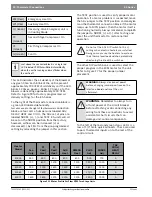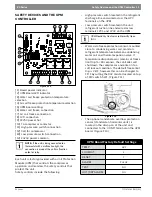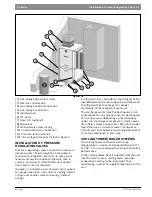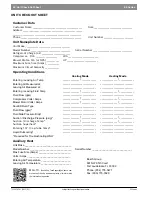
18
|
Sequence of Operation
ES Series
ES Series
T111970291 (2015/01)
Subject to change without prior notice
SEQUENCE OF OPERATION
Cooling Mode
Energizing the “O” terminal energizes the unit
reversing valve in the cooling mode. The fan motor
starts when the “G” terminal is energized.
When the thermostat calls for first stage cooling
(Y1) the loop pump or solenoid valve if present is
energized and the first stage of compressor
capacity starts. The fan ramps up to first stage
cooling air flow in 30 seconds.
When the thermostat calls for second stage
cooling (Y2) the second stage (or full compressor
capacity) is initiated. The fan ramps up to full
cooling air flow.
Once the thermostat is satisfied, the compressor
shuts down accordingly and the fan ramps down to
either fan only mode or off over a span of 30
seconds.
Heating Mode
The first two stages of heating (Y1 & Y2) operate in
the same manner as cooling, but with the reversing
valve de-energized. On a call for auxiliary heat
(W1), the fan ramps up to auxiliary heat air fl ow
immediately and the electric heater package is
energized along with the compressor. As the
thermostat is satisfied, the heaters will shut off as
soon as W1 is de-energized, and the compressors
will remain on until the thermostat stages are
satisfied. Note that if the unit compressor lock out
for any reason at this time, the electric heaters will
continue to function normally.
OnES the thermostat is satisfied, the compressor
shuts down and the fan ramps down either fan only
mode or off over a span of 30 seconds.
If thermostat has two different output points one
for Auxiliary heat and a different one for
Emergency heat the two outputs must be
terminated on W1 units equipped with one stage
of Electric heat. (Figure #)
APPLICATION CONSIDERATIONS
Well Water Systems
Copper is adequate for ground water that is not
high in mineral content. Should your well driller
express concern regarding the quality of the well
water available or should any known hazards exist
in your area, we recommend proper testing to
assure the well water quality is suitable for use
with water source equipment. In conditions
anticipating moderate scale formation or in
brackish water a cupro-nickel heat exchanger is
recommended.
In well water applications water pressure must
always be maintained in the heat exchanger. This
can be accomplished with either control valve or a
bladder type expansion tank. When using a single
water well to supply both domestic water and the
heat pump, care must be taken to insure that the
well can provide sufficient flow for both.
Solenoid valves should be connected across Y1
and C1 on the interface board for all. Make sure
that the VA draw of the valve does not exceed the
contact rating of the thermostat. (Figure #18)
The fan motor will take 30 seconds to ramp up
to operating speed and will run at fan only rated
air flow as long as there is no call for compressor
or heater operation.
A fault condition initiating a lockout will de-
energize the compressor irrespective of which
stage is engaged.
NOTE:
In well water applications a slow
closing solenoid valve must be used to
prevent water hammer.
















































